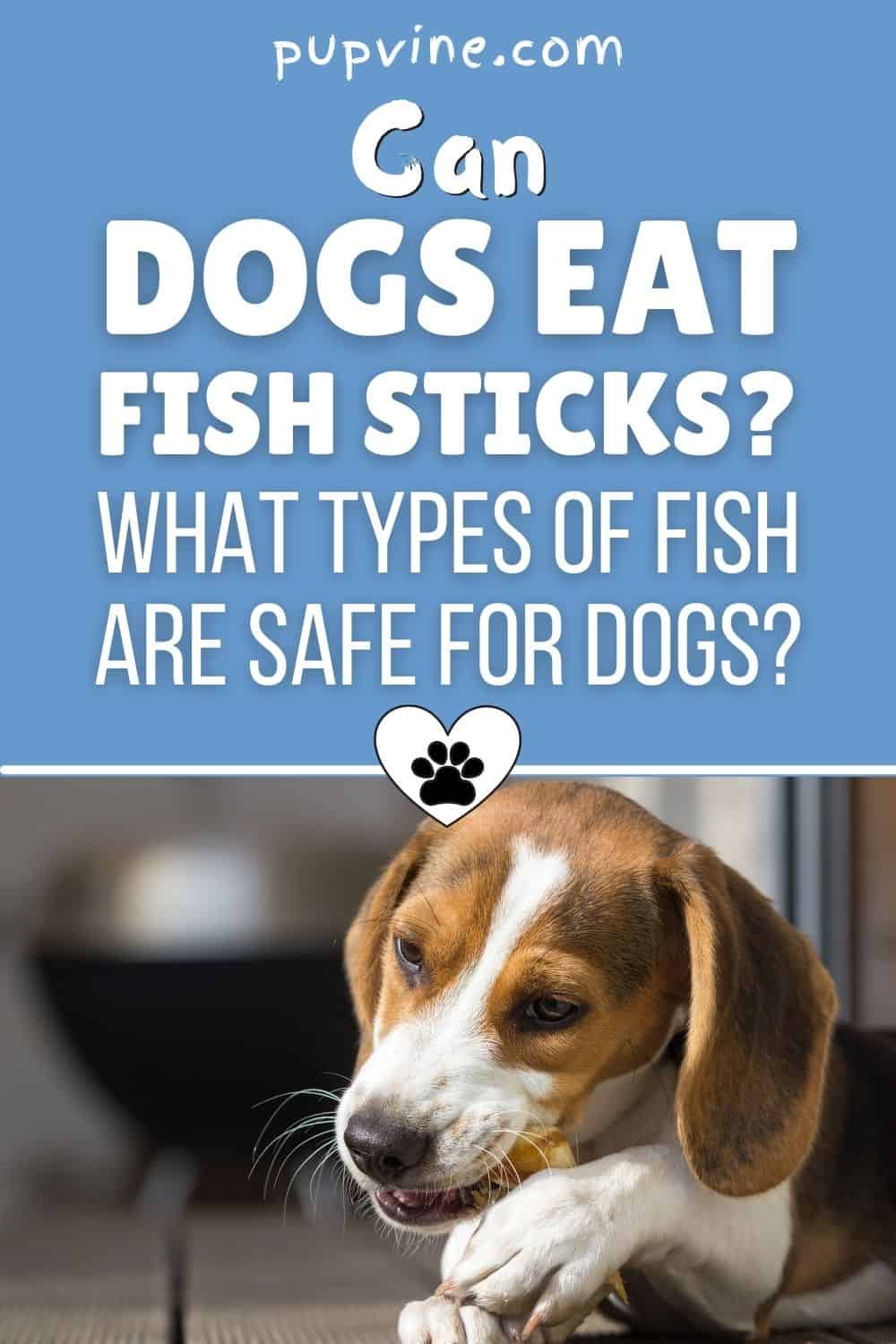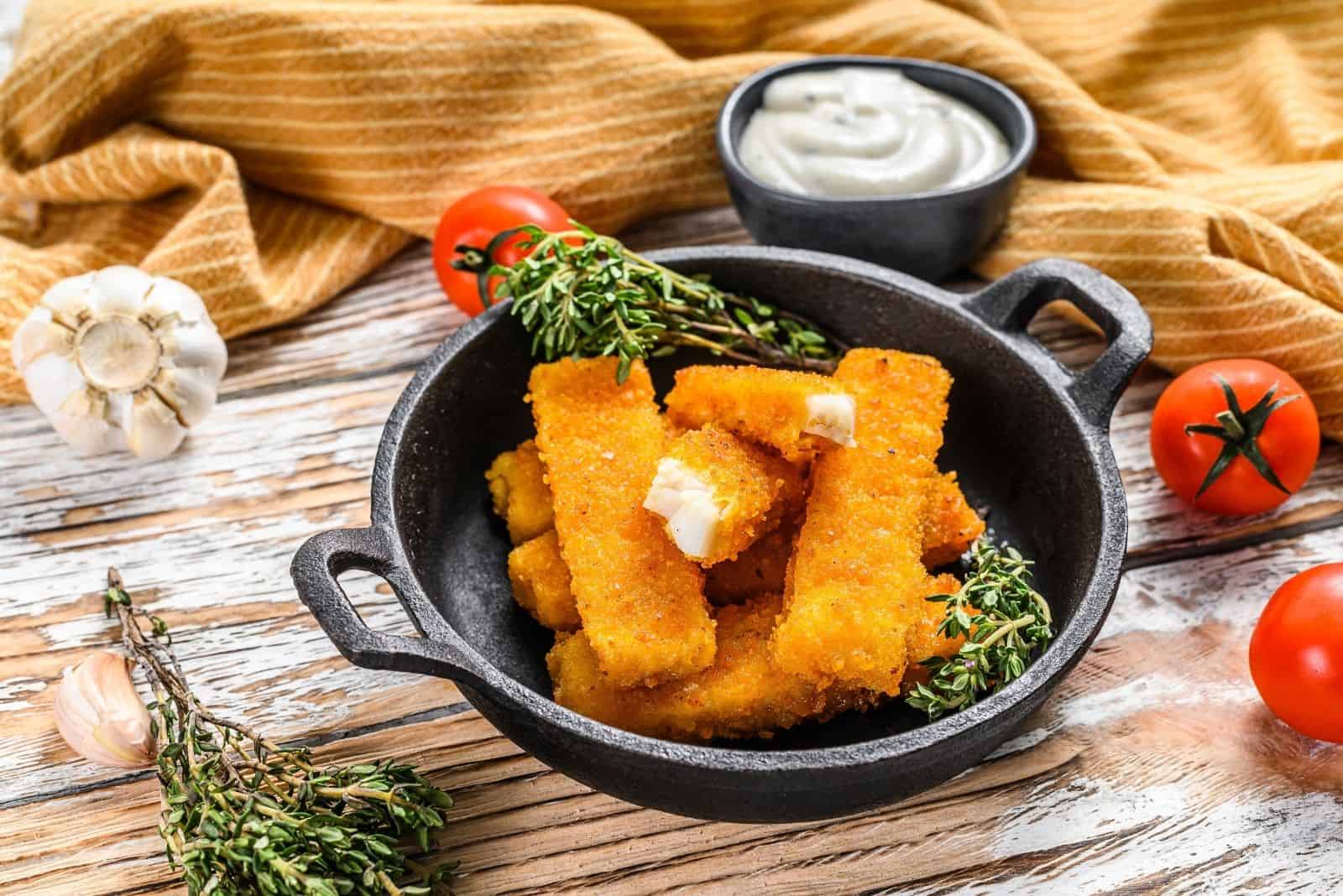I know a lot of dog owners are tempted to feed their dogs off their plates. Sure, a bit of your fried fish won’t kill your Fido, but let’s not make this a habit. Let’s promote good eating habits for both us and our dogs.
Today’s field of interest is: Can dogs eat fish sticks?
I’m sure some of you have pondered this question. I’m also sure a lot of you have given fish sticks as an occasional treat before. But, I’m here to make things right and stop this unnecessary treat.
Fish brings many health benefits. Fish fingers? Not so much.
In order to understand why fish fingers aren’t that safe for dogs, you will need to first learn what makes fish fingers.
Let’s sneak into the food industry and see how fish sticks are made!
Tell Me More About Fish Sticks?
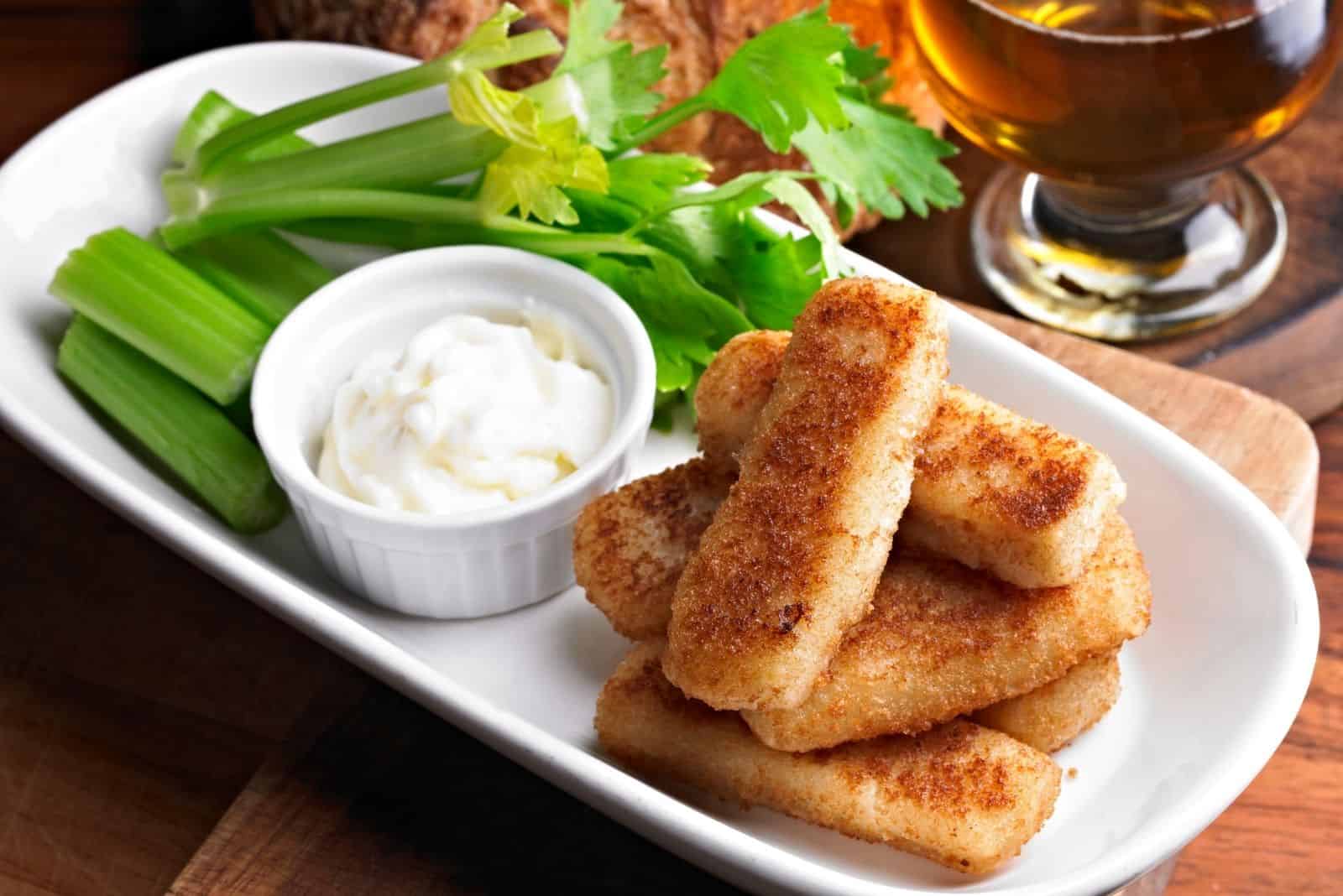
Admit it… we all have reached out and grabbed the first thing from the freezer for a quick lunch. Usually, it’s some sort of processed meat or fish sticks. Sure, we used to get them in school, but little did we know back then.
Even though they have “fish” listed under their name, fish sticks aren’t necessarily good for you. They’re still processed food and their nutritional value is not so brilliant.
Fish sticks or fish fingers are a breaded combo of different fish types. Food brands usually make them using white fish such as pollock, haddock, cod, hake, etc. They just chop up all kinds of fish parts, grind them, and we get fish sticks.
Yeah, bones get ground, too!
Fish fingers are then battered and frozen. You will find them in food aisles with frozen products, usually for a cheap price. Well, their price says a lot about their quality.
Fish sticks are ready to be baked in the oven, deep- or shallow-fried, or grilled without previous thawing. In case you didn’t know, sudden thawing of frozen food can even cause more problems and bring out fast-growing bacteria.
This is not a healthy meal for anyone, much less for dogs!
So, Can Dogs Eat Fish Sticks?

Technically, dogs can eat fish sticks. But, it doesn’t mean they should.
Fish fingers aren’t toxic for dogs like some food, but certain components can be dangerous if consumed too much.
Sure, you can give an occasional treat in the form of a fish stick, but let’s not make a habit out of it. Nothing will happen to your dog if he grabs a fish finger off your plate.
You see, it’s the many seasonings that are actually bad for your dog, and they’re contained in the fish sticks’ recipe. Usually, food brands throw in onion and garlic powder to make them tastier.
Onions and garlic, whether fresh or powdered, are harmful to dogs. They might not poison your dog, but these seasonings can cause vomiting, diarrhea, and other stomach problems.
Also, fish sticks contain too much salt not only for dogs, but also for we humans. Dogs shouldn’t consume salt as it can cause severe dehydration and salt poisoning.
The last thing that should worry you about fish fingers is the coating or the breading. Breading soaks in a lot of oil which is extremely harmful for dogs.
All in all, it’s better to skip feeding fish sticks to your dog.
Why Are Fish Sticks So Undesirable?

Fish sticks are full of preservatives, carbs, empty calories, and fats.
And, this is only the tip of the iceberg!
There are lots of other reasons for fish sticks being so undesirable. For starters, let’s discuss what they are made of.
Fish fingers are made using white fish… all parts of it. When we look at the nutritional value of fish, we see that white fish is at the bottom of the ladder. Fatty fishes like mackerel and salmon are much healthier, but we don’t see brands making sticks out of them.
Why is that so?
White fish is more common and easier to catch than salmon, for example. Think of huge fishing boats catching fish with those giant nets.
Yup, that’s why they’re so affordable! In terms of quantity, there’s much more white fish in the sea than other, more quality types.
Fish sticks are also undesirable because of the breading. I normally don’t consume deep-fried food. Do you? I’m not judging at all, but stop for a second and think how unhealthy it is. All that bread is covered in oil. No thanks! My dogs agree with me.
Too much fat in a dog’s diet is a starting point for many diseases such as indigestion,bloating, or pancreatitis.
A diet rich in bad fats, oils, and carbs will lead to cardiac problems, cholesterol, as well as obesity. I think our canine friends are already facing some major life difficulties with growing up or fighting breed-related diseases. Do you really think they need obesity on top of that?
Now, I know food brands list ingredients on the back of their products, but I normally don’t trust them. I always believe they’re hiding something. Still, even if they’re very transparent, ingredients like garlic or onion powder, salt, baking soda, etc. have nothing to do with a dog’s diet.
These ingredients may cause vomiting and diarrhea. If your dog consumes food high in sodium, the worst-case scenario includes seizures, uncontrollable shaking, and tremors.
Lastly, when was the last time you ate a fish stick? Compare the taste to a freshly-caught salmon or trout. It tastes like anything BUT fish. Am I right? Even though dogs are dogs and they might eat their own vomit, I don’t believe they will think fish fingers are particularly tasty.
So, Should My Dog Skip Any Type Of Fish?
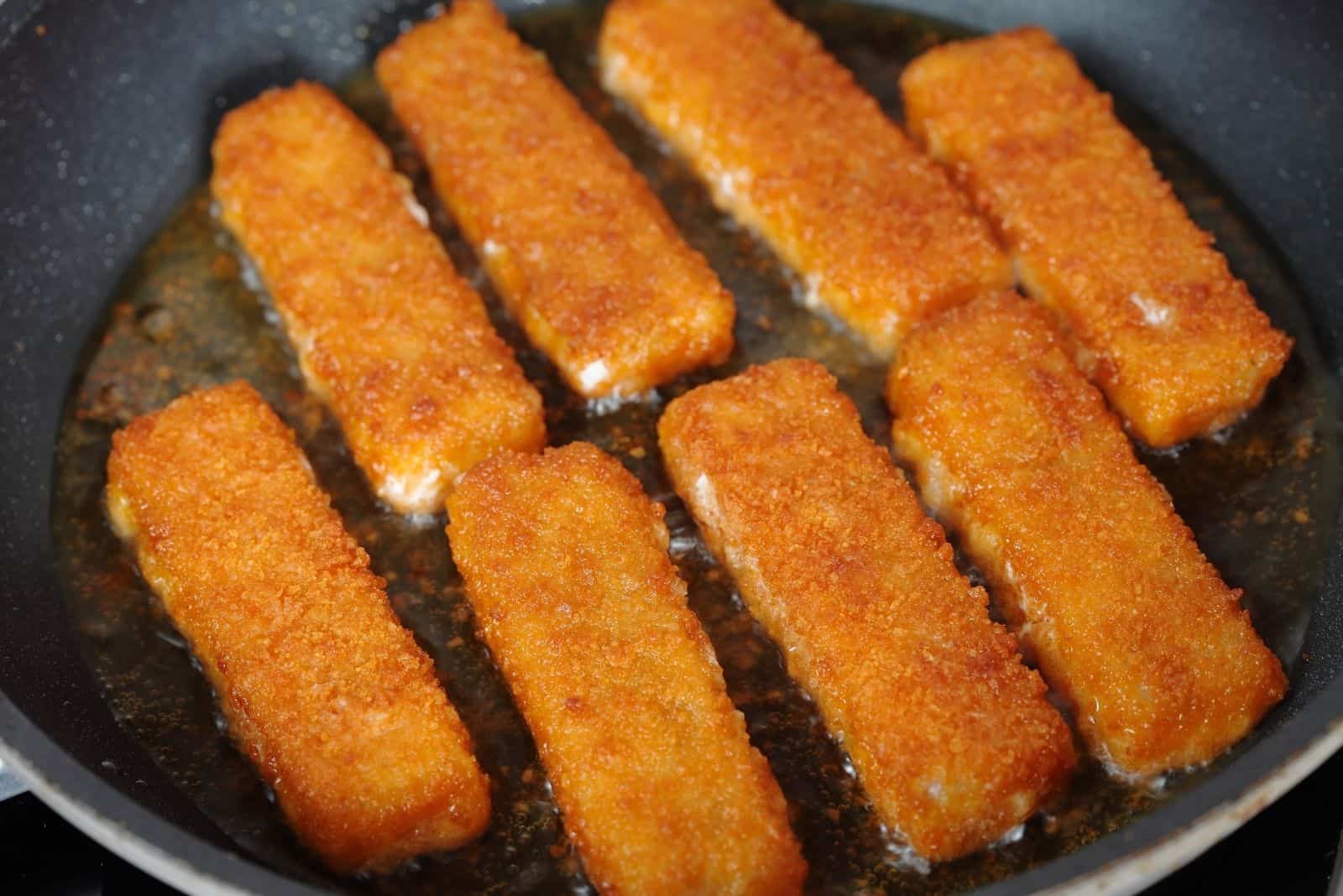
Well, besides these notorious fish sticks, dogs shouldn’t eat certain types of fish because they contain high levels of heavy metals.
For example, tuna is the only type of fish dogs can eat raw and cooked. But, it shouldn’t be consumed too often. Tuna and mackerel contain high levels of mercury, which, if ingested in a big amount, can cause poisoning.
Speaking of seafood, dogs shouldn’t eat shellfish. They are known as filters of the sea, which means they filter the water, trapping heavy metals and toxins inside them. Too much shellfish may lead to food poisoning with dogs, no matter how fresh they are.
When it comes to fish that is safe for dogs, it’s not only about the type, it’s more about the way of preparation. Dogs should never consume smoked fish since it contains too much salt.
Raw fish is also a big no since it could contain salmonella and other parasites. So, there’s no excuse for giving your dog sushi off your plate. Just don’t ever do it!
Lastly, you should always be sure where the fish comes from. Farmed fish, like pangasius, live in filthy waters, surrounded by dirt, plastics, and garbage. They’re treated with pesticides and antibiotics. Think of them as a close relative to GMO food, and that’s something we don’t do!
Is Feeding Fish Healthy For Your Dog?
https://www.youtube.com/watch?v=bE4FAKnmYuU
Ever since we were little kids, our parents have told us that eating fish brings many benefits and will keep us healthy.
Well, they were absolutely right!
Now, it’s time to transfer that knowledge to our furry babies.
I’m just kidding because dogs have no idea what we’re talking about. Still, this doesn’t minimize the many benefits that a pescatarian diet has.
The first thing that could come to mind as to why regular fish intake is good for you is the number of proteins it carries. All creatures need proteins for normal development, growth, and functioning.
That’s why we strive to get dog food with the highest amount of real proteins for our pooches.
Fish-based dog food is a great choice, especially when you have a puppy prone to food allergies. Dog kibble that contains beef or poultry usually triggers allergies, so a dog needs something light and lean. Enter, fish kibble!
Fish kibble contains not only the necessary proteins, but it’s rich in omega fatty acids that keep our dog’s brain and brawn functioning like a swiss clock.
Omega-3 acids are essential in a dog’s diet if you want a dog with a healthy and shiny coat. But, fatty acids don’t only do good for the outer looks. They’re beyond beneficial for the inside, too.
These acids reduce the risk of arthritis with senior dogs. They improve a dog’s mobility and give support to problematic hips and joints.
Also, experts have proven that omega-3 acids work wonders on everyone’s immune system. They fight inflammation, infections, and any current hotspot.
Dogs should consume food rich in these nutrients from day one after their weaning. It will affect their cognitive abilities and help them learn faster. Dogs need to keep their mental health on a satisfying level, and fish is the right food for that!
Also, I recommend fish dog food since it’s very light on the stomach and easy to digest. It’s perfect for those pooches suffering terribly from bad digestion.
What Kind Of Diet Do Dogs Need?

Just because they’re dogs doesn’t mean they can eat just about anything. No, don’t you dare hand out your dog table scraps! I know many people are feeding them to dogs and still wonder why they have so many health problems.
Human food contains excessive amounts of salt. It’s bad for your dog’s digestion and its kidneys. A lot of salt can even kill a dog, so don’t joke with that! Other harmful seasonings like pepper or chili flakes are another big fat no.
Your furry friend should eat food with a great source of protein such as beef, chicken, fish, lamb, turkey, or pork. The nutritional benefits of foods rich in proteins are greater than you think. Do you know why? Because dogs don’t need grains and other fillers to keep them growing!
Dogs need a healthy balance of proteins, minerals, vitamins, fatty acids, and fibers to keep their health issues under control.
Sadly, I see many dogs nowadays with severe food allergies. Is it because of poor breeding or is it just bad luck? I don’t know. But, I do know a lot of them are consuming fish-based kibble.
That’s right, fish-based kibble… not fish sticks. There is no such thing as dog fish sticks, and you shouldn’t regard them as a treat. If your dog has food sensitivities, ask your vet to prescribe you special food.
And, no matter which food you get, never feed your dog deep-fried breaded fish sticks! If you want only the best for your dog’s health, then don’t think that fish sticks are safe all the way.
Do Dogs Like Raw Food?

Dogs are carnivores by default. Back in the day, there was no wet or dry dog food. There was only raw dog food.
With the rise of prices and the beginning of the dog food industry, raw dog food has been abandoned. Only some reputable breeders are using it today.
However, I see that raw dog food is coming back grand style. More and more dog owners are opting for the raw diet since it gives their dogs more energy and more benefits. Also, a raw diet controlled by the owner gives better insight into what the dog is consuming.
When I say raw dog food, I mean meat coming from beef, lamb, pork, or poultry. Raw dog food using only fish is not recommended at all. For starters, fish have bones that can get trapped in a dog’s throat.
Also, a fish’s skin is usually a carrier of some parasites and a fertile ground for bacteria development. You shouldn’t give your dog fresh fish under any condition.
Yes, tuna is okay from time to time, but I wouldn’t go overboard with it.
To sum up, a big yes for raw dog food containing red or white meat, and a big no for fish-based raw food.
You get the point, don’t you?
Are There Any Healthy Substitutions To Fish Sticks?
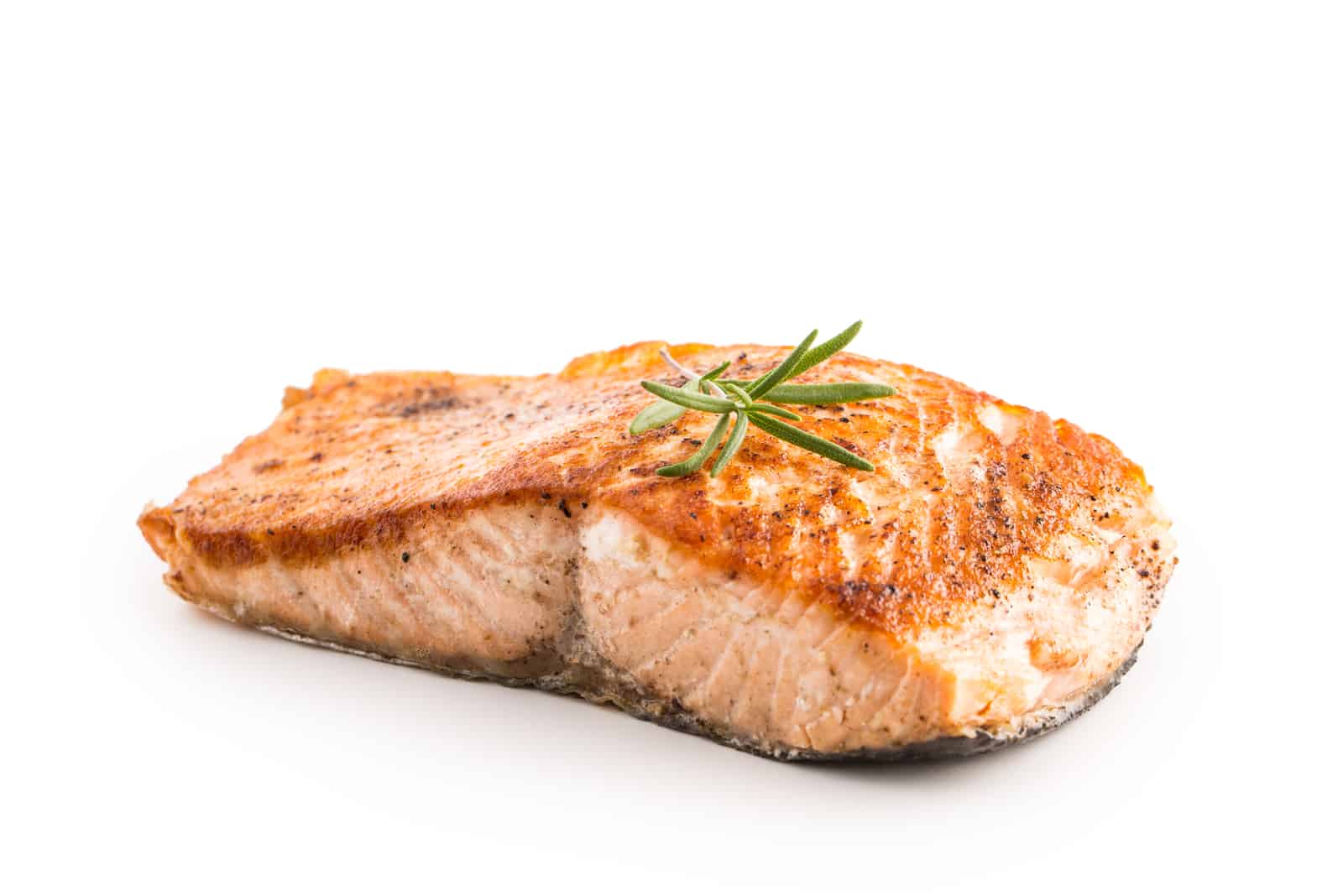
The only healthy alternative to fish sticks is actual fish, untreated with pesticides and cooked so parasites and bacteria are destroyed.
Veterinarians recommend you choose fish that’s packed with omega-3 fatty acids. My first choice is always salmon. Yes, I agree it’s one of the tastiest fishes out there.
A piece of salmon should be baked without any seasonings like salt. Just put it in the oven for 10 to 15 minutes until it’s done, and chop it into tiny bits so your dog eats it without any problem.
Salmon is packed with healthy fats that benefit dogs’ bones and brain, and reduce inflammations.
Besides salmon, sardines and cod are also good choices. Just make sure you buy the ones canned in water and in their natural juices instead of in oil.
FAQs

Photo from: @malteseclub_lover
Can Dogs Eat Breaded Fish?
I don’t recommend feeding your dog breaded fish because of the manner of preparing it.
Almost everyone prepares breaded fish by frying it in shallow or deep oil. The bread soaks so much oil that it’s almost disgusting. And, it’s beyond unhealthy!
Too much oil in a dog’s diet can cause obesity and chronic inflammation. No matter its breed, no dog deals with obesity like it’s nothing.
Obesity is a severe condition, and it could lead to numerous other problems.
So, I’m putting a veto on breaded fish for my dogs. Are you, too?
Can Dogs Eat Alaskan Pollock And Similar Fishes?
Yes, your dog is safe to eat Alaskan Pollock.
This is a delicious white fish filled with omega-3, which brings many benefits to your dog. Just make sure you oven-bake it without excessive oil, salt, and other seasonings.
Still, keep in mind that white fish in general is low in nutrients. If you must feed your dog fish, choose another type.
Can Dogs Eat Cod Fish?
Cod is a lean fish and a favorite of we humans. I see no reason why it shouldn’t be a favorite of dogs, too.
Just like Alaskan Pollock, cod should be prepared the right way and enjoyed in a normal amount.
Can Dogs Eat Frozen Fish Sticks?
There’s really no difference between fish sticks and frozen fish sticks: they’re the same thing!
Well, frozen fish sticks are, by far, less tasty since dogs have to chew through frozen bits and digest them. This may even lead to some dental damage caused by frozen food.
I don’t recommend you feed either of these to your dog. I mean, you wouldn’t eat frozen food, so why should your dog?
Which Body Parts Of A Fish Can Dogs Eat?
Dogs can eat pretty much the entire fish with some exceptions.
A fish’s skin should be cooked or baked in the oven without any seasonings. You must kill bacteria and parasites that lie on the skin’s surface.
Fishbones and fins are also a big no. Lodged bones may cause internal damage to the dog’s throat, stomach, or intestines. This can cause further issues with internal bleeding or infections.
So, you need to be extra careful not to give your dog fishbones. I remember seeing my friend feeding fish with bones to her cat and offering mine some, too. I don’t like to think what would’ve happened if I didn’t stop her. Thank God, she knows better now.
As for fish heads, you’re clear to give your dog some as they’re rich in proteins and omega-3. Basically, you’re giving your dog brain food that’s actually a tiny fish brain! How awesome is that?
Can Dogs Eat Canned Fish?
This depends on which fish is hiding in that can and how it’s treated.
I don’t recommend any fish canned in oil. Go with the healthier option of fish canned in its own oils or in water. Canned tuna and swordfish are okay from time to time. But, control the dosage in order to avoid mercury poisoning.
What Kind Of Fish Is Used To Make Dog Food?
Did you really think common white fish will make the cut and be used as the number one ingredient of fish dog kibble?
Think again!
Most dog food brands use salmon as the first ingredient, followed by flounder, arctic char, pike, herring, lake and ocean whitefish, etc.
I’m really surprised with the current offer on the market since there are plenty of excellent dog foods with fish as the first ingredient.
To Sum Up…
The answer to the question: Can dogs eat fish sticks is…
Yes.
But, let me explain my answer.
This isn’t really a yes or no question. You need to dig deep into the matter to figure out why fish sticks are undesirable.
Generally speaking, no processed food is good for your dog. If you’re really planning on feeding them fish, just cook fish, grill it, or buy fish-based dog kibble on Amazon.
A pescatarian diet is wonderful, and it brings so many amazing benefits that you’re probably not aware of.
I suggest you overcome your prejudices and see how delicious fish is. That’s right, fish… not fish fingers. Get it?
